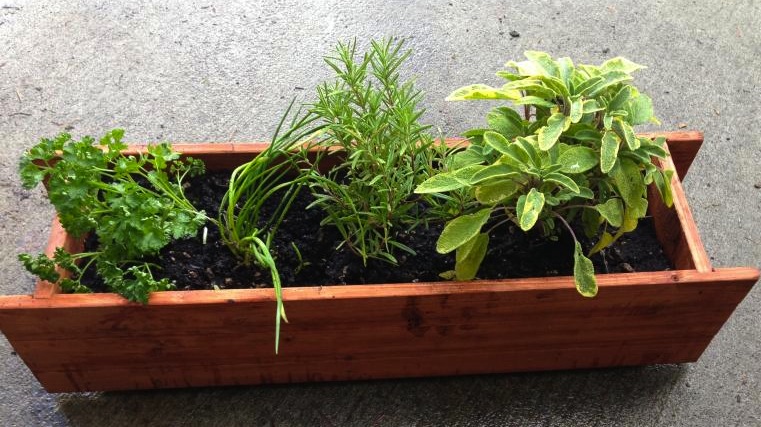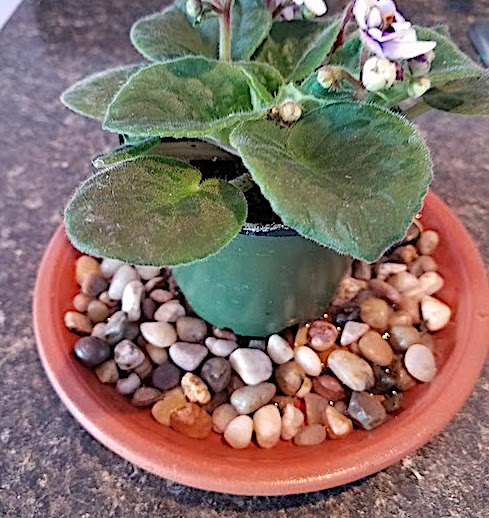Indoor Herb Gardens
Savor summer flavor in winter weather
by Marsha Goldberg, Fairfax Master Gardener
If you love growing and cooking with fresh herbs, don’t let cold temperatures put an end to your fun. Plant a windowsill herb garden, and continue to enjoy fresh herbs in winter without having to pay high prices for puny grocery-store bundles.

Small container to bring inside for windowsill
You can grow many herbs indoors–including basil, bay, chervil, chives, cilantro, dill, oregano, parsley, rosemary, sage, tarragon and thyme—as long as you have a window that gets at least six hours of direct sunlight a day. While your plants won’t be as bushy as their outdoor summer counterparts, they will provide enough leaves to snip and savor in your winter dishes.
Getting started
You can sow some herbs, such as basil, cilantro, dill and parsley from seeds. Perennial herbs such as chives, oregano, thyme, rosemary and sage are easier to grow from small purchased plants, or you can divide or take cuttings from the plants in your garden. (Cuttings from the garden, however, may not root and grow quickly enough to give you an ample amount to snip for cooking.) To root a cutting, cut off about four inches from the plant and strip off the lower leaves. You can dip the bottom of the cutting in rooting hormone, available at garden or hardware stores, but this is not absolutely necessary. Poke a hole in a moist potting mix, and gently push in the cutting. Cover the pot for a few weeks with plastic wrap or a plastic bag to create a humid environment, and keep the planting medium moist.
Choosing a potting medium
Use a soil-free mix, good-quality potting soil, or a mixture of both for your indoor herbs. They will do best in soil that drains well but can stay slightly moist. Do not use soil or compost from your garden as these are heavier and may contain insects or diseases that you do not want to bring inside. Moisten the potting medium lightly before you sow your seeds or insert the cuttings.
Use a pot or container with a hole in the bottom, as herbs do not like wet feet. You can use plastic, terracotta or ceramic pots but remember that plastic pots hold moisture the longest. Terracotta dries out more quickly, so you will need to adjust your watering schedule accordingly.
Bringing herbs indoors
Bring plants indoors before the first frost. For a more in-depth discussion about the best strategies to use when bringing plants inside, see Welcome Back, Begonia!
Give the plants a transition period. Leave them outside during the day, but bring them in at night so they can get used to indoor temperatures and moisture levels. Check to see that the plants are free of bugs and other pests. If you see signs of insects, you can hose them off gently or fill a basin with soapy water, place your hand over the dirt in the pot, turn it over, and dip the plant a few times in the soapy water before rinsing it with plain water. Be sure to continue to monitor the plant for pests once you bring it inside. Keep any herbs that had pests away from the other plants in your house until you are sure that you have eradicated the bugs. If you continue to see insects, you can repeat the soapy bath or try using insecticidal soap, which is organic and safe to use on food. Be sure to follow the directions, and wash off the soap before you use the herbs. Also, monitor your indoor environment, as plants are more susceptible to bugs when they are in hot, dry conditions.
Controlling temperature
If your plants are on a windowsill, make sure the leaves do not touch the glass, as they may freeze in the cold weather. An environment that is 65 to 70 degrees (18-21°C) during the day and 55 to 60 degrees (13-15°C) at night is ideal.

Tray with pebbles and water
Watering and maintaining humidity
Be careful not to overwater. The soil should be lightly moist but not soggy. Feel the top inch of soil with your finger. If it feels completely dry, it is time to water, but if you feel any moisture, hold off for a few more days. Give the plant enough water so that it drains from the bottom of the pot.
Herbs grow best when there is some humidity in the air. This also helps their resistance to pests. To ensure adequate humidity, fill a tray with pebbles, and add water to just cover them. Place the potted herb on top of the pebbles. The plant will absorb moisture as it evaporates from the tray. Check the tray every few days as the water can evaporate quickly.
Fertilizing
You can use a time-release fertilizer when you pot the plants and half-strength solution of water-soluble fertilizer every two weeks throughout the indoor season, but it is not absolutely necessary until the end of December when the days start to slowly get longer and plants get ready to break their dormancy.
Begin setting the plants outdoors during warm days in late April, and leave them outdoors when the temperature remains above 50 degrees (10°C) at night.
…updated 2024
-
Resources
- Growing Herbs in Containers and Indoors, University of Maryland Extension Extension
- Herbs for Your Winter Windowsill, Pat Curran, Cornell Cooperative Extension Tompkins County